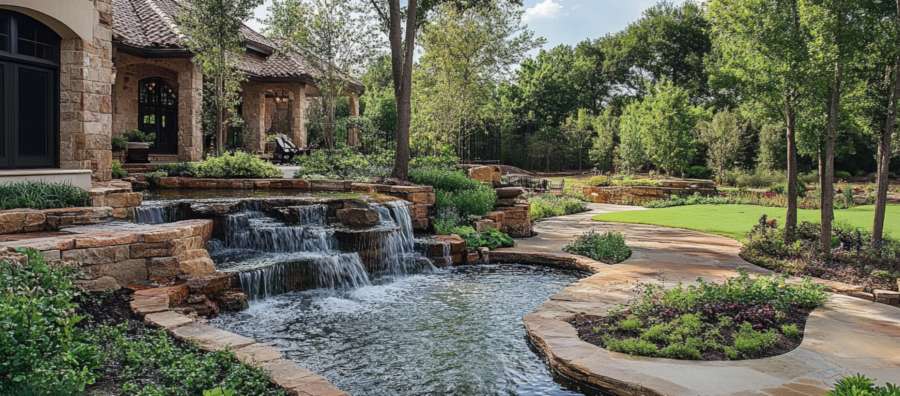Water Features: The Art of Liquid Camouflage
There’s something special about the way water drowns out unwanted sounds. It’s like nature’s version of noise-canceling headphones, except it doesn’t need batteries and won’t mysteriously disappear into the couch cushions. Fountains, waterfalls, and babbling brooks not only add a touch of elegance but also create a consistent, soothing sound that masks traffic, lawnmowers, and that guy next door who thinks he’s the next great podcast host.The key is to choose a water feature that produces a pleasant frequency. A gentle, trickling fountain might be perfect for a quiet suburban setting, but if you’re dealing with serious noise pollution, you may need a full-blown waterfall to get the job done. A well-placed water feature can turn even a city backyard into a peaceful oasis—just be prepared for birds to start treating your space like an exclusive spa.
Plants: The Green Soundproofing Experts
Plants do more than just look good and provide oxygen—they’re also highly effective at absorbing and deflecting noise. Dense shrubs, leafy trees, and climbing vines all work together like a natural barricade against unwanted sound. The thicker the vegetation, the better the results. Think of it as the plant equivalent of throwing a blanket over a speaker—except it actually works.For best results, layer your greenery. Start with tall trees, like evergreens, to block sound at higher levels. Add medium-height shrubs to catch mid-range noise, and finish with ground cover plants for the low-end frequencies. Bamboo is another excellent option—it grows quickly, provides fantastic sound insulation, and adds an exotic touch to your space. Just make sure you pick a clumping variety unless you want to accidentally recreate a jungle.
Barriers: The Great Sound Walls
When plants alone won’t cut it, solid barriers step in to save the day. A well-placed fence, wall, or hedge acts as a physical shield against noise, forcing sound waves to bounce away rather than invade your peaceful hideaway.Wooden fences with overlapping boards are excellent for blocking noise, but if you want something even more effective, consider a masonry wall. Brick, stone, and concrete don’t just block sound—they absorb and diffuse it, making them a top-tier choice for serious noise reduction. For a softer look, you can combine hard barriers with climbing plants to get the best of both worlds.
If you’re feeling creative, a combination of fences, plants, and water features can work together like an elite team of soundproofing professionals—only with more leaves and less paperwork.
Strategic Landscaping: Positioning Matters
You wouldn’t put your sofa in the middle of the street and call it a living room, so why treat your landscaping any differently? Where you place your sound-reducing elements makes all the difference.Start by identifying the source of the noise. If it’s coming from the road, position your barriers and plants closer to the property line. If it’s from a neighbor’s backyard karaoke nights (which, despite their confidence, are not Grammy-worthy), set up your noise-blocking elements in a way that directly intercepts the sound before it reaches your relaxation zone.
Curved walls and staggered plantings work better than a straight-line approach. Sound waves travel like unruly children—if you give them a direct path, they’ll charge right through. But introduce obstacles and curves, and they start bouncing around, losing energy along the way. By the time they reach your ears, they’re weak, exhausted, and significantly less annoying.
The Unsung Hero: Ground Cover
People often overlook the role of ground cover in noise reduction. But think of it like carpeting for your yard—soft surfaces absorb sound much better than hard ones. Grass, mulch, and low-growing plants help muffle footsteps, echoes, and the clatter of patio furniture being rearranged at an unreasonable hour.A lush lawn is great, but if mowing it feels like a part-time job, consider alternatives like creeping thyme, moss, or ornamental grasses. These require less maintenance while still contributing to a quieter environment. Plus, they add a soft, natural look that pairs well with other soundproofing elements.
Wind: The Wild Card
Before you get too carried away with water features, walls, and foliage, take a moment to consider the wind. A well-placed hedge can block gusts that would otherwise carry sound straight into your backyard, while trees with rustling leaves can add a layer of white noise that makes disturbances less noticeable.That said, not all wind-related sounds are soothing. If you’ve ever heard bamboo clanking together like an overenthusiastic percussion section, you know what I mean. Choose plants and materials wisely—dense evergreens won’t rattle, and properly secured fences won’t turn into musical instruments when the wind picks up.
Peace and Quiet, Delivered Naturally
Noise is a fact of life, but that doesn’t mean you have to accept it invading your outdoor space. By combining water features, strategic plantings, solid barriers, and a bit of thoughtful positioning, you can create a backyard that feels like a retreat rather than a front-row seat to the neighborhood’s daily chaos.The best part? Once you’ve set up your sound-friendly landscape, you get to sit back, relax, and enjoy the serenity—until the local wildlife decides your space is their new favorite hangout. But hey, at least birdsong is better than car horns.
Article kindly provided by candenativelandscape.com


